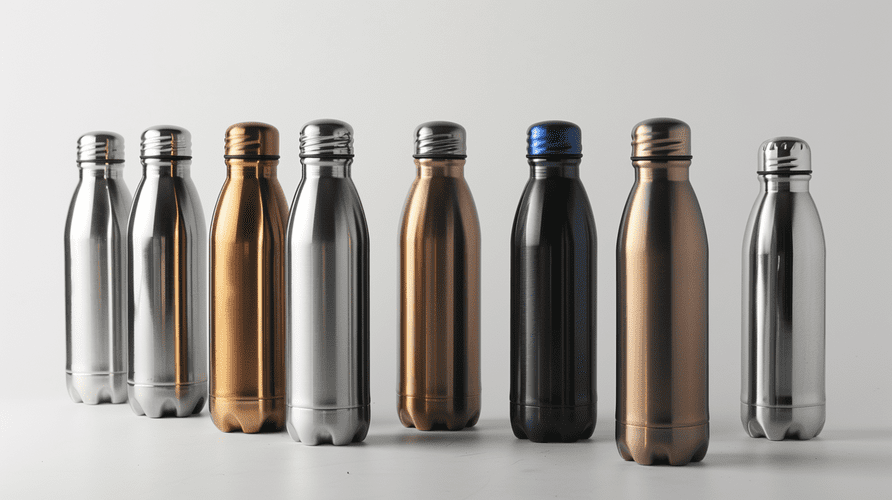Are you worried about chemicals leaching from plastic bottles? These hidden risks can affect your well-being. Stainless steel provides a safer, more durable way to stay hydrated daily.
Yes, using stainless steel water bottles offers significant health advantages. They are typically BPA-free, do not leach harmful chemicals into your drinks, resist bacteria growth, and are easy to keep clean, ensuring your water stays pure and safe to drink every time.

Choosing the right water bottle material is important for health. Many people I talk to, like Mark Shenng, a business owner in Canada, are moving away from plastics. They see the value in safer alternatives. But questions remain about how safe steel really is and how it compares. Let's look closer at why stainless steel is a great choice for health-conscious individuals and businesses.
Is it healthy to drink out of stainless steel bottles?
Concerned if metal is truly safe for your drinks? Maybe you've heard confusing things. High-quality stainless steel is proven safe and widely used for food and drinks globally.
Absolutely, drinking from a quality stainless steel bottle is very healthy. Food-grade stainless steel, like 18/8 grade, doesn't release harmful chemicals or metallic tastes into your water. It's naturally resistant to rust, corrosion, and bacteria buildup, keeping your drink pure.

When we talk about health, the material itself is key. Not all stainless steel is created equal, which is why focusing on quality, a major concern for buyers like Mark, is essential.
Understanding Stainless Steel Grades
The most common type used for food and drink containers is Type 304 stainless steel1, also known as 18/8. This name refers to its composition: 18% chromium and 8% nickel.
- Chromium: Provides resistance to rust and corrosion.
- Nickel: Enhances durability and adds to the corrosion resistance.
This specific blend makes 18/8 stainless steel non-reactive. It means the metal won't interact with your beverages, whether it's plain water, acidic juice, or milk. You don't get any metallic taste, and more importantly, no harmful substances leach into your drink. This is a huge advantage over some plastics that can leach BPA or other chemicals, especially when exposed to heat or over time. I remember working with a client who was hesitant initially, but after verifying our material certifications, they became confident in the safety of our 18/8 steel bottles.
Hygiene and Cleanliness
Another health benefit is how easy stainless steel is to clean. Its smooth, non-porous surface doesn't harbor bacteria easily, unlike some plastics that can develop scratches where microbes hide. Thorough washing with soap and water is usually sufficient. For businesses providing branded bottles, ensuring the product is easy for the end-user to keep hygienic is a subtle but important quality feature.
What is the healthiest water bottle to drink from?
Feeling lost in the sea of water bottle options? Do you just want the safest, healthiest choice? Material safety and how easy it is to clean are top factors.
Generally, high-quality stainless steel2 and glass bottles are considered the healthiest options. Both avoid the chemical leaching concerns associated with many plastics. Stainless steel adds durability and insulation, while glass offers purity but breaks easily. Both are excellent choices for health.

Choosing the "healthiest" bottle involves weighing different factors. While stainless steel and glass lead the pack for material safety, other aspects like durability, usability, and specific needs matter too. Let's compare the most common options.
Material Comparison: Health & Practicality
| Feature | Stainless Steel (18/8) | Glass | BPA-Free Plastic3 (e.g., Tritan) | Aluminum (Lined) |
|---|---|---|---|---|
| Chemical Safety | Excellent (Non-leaching) | Excellent (Inert) | Good (BPA-free, check type) | Depends on liner integrity |
| BPA-Free | Yes | Yes | Yes | Bottle yes, liner maybe |
| Durability | Very High | Low (breakable) | Medium to High | Medium (dents easily) |
| Weight | Medium | Heavy | Light | Very Light |
| Insulation | Good (double-walled) | Poor | Poor | Poor |
| Cleaning | Easy | Easy | Can scratch/stain | Liner can damage |
| Taste Neutral | Yes | Yes | Generally Yes | Can have taste issues |
As you can see, 18/8 stainless steel offers a superb balance. It matches glass for chemical safety and taste neutrality but far surpasses it in durability. For businesses like Mark's, who rebrand and sell products, durability is crucial for customer satisfaction and brand reputation. While BPA-free plastics are lighter, potential microplastic shedding and lower durability are downsides. Aluminum bottles almost always require an internal liner (often epoxy or plastic-based) which can degrade or get damaged, potentially exposing the aluminum or leaching chemicals.
I recall a conversation with a procurement manager who switched their corporate gifting from plastic to stainless steel bottles. They emphasized not just the health aspect but also the perceived value and longevity, reflecting better on their brand. Ensuring our bottles meet standards like FDA and LFGB gives buyers confidence in this safety.
When should I throw away my stainless steel water bottle?
Think your stainless steel bottle will last forever? Are you worried about wear and tear you can't see? Knowing when it's time for a replacement is smart.
Unlike plastics, stainless steel bottles don't really expire or degrade chemically. You only need to replace it if it's physically damaged (like deep dents affecting insulation, cracks, or broken seals) or if you notice rust (very rare in quality steel).

High-quality 18/8 stainless steel4 is incredibly durable, designed for years, even decades, of use with proper care. Its longevity is a major environmental and economic benefit. However, no product is indestructible. Knowing what to look for helps ensure you're always using a safe and effective bottle.
Signs Replacement Might Be Needed
- Visible Rust: This is uncommon with food-grade 18/8 stainless steel. If you see rust spots inside, it might indicate lower-quality steel was used, or the protective chromium layer has been severely damaged (e.g., by harsh abrasives). While small spots might be cleanable, widespread rust compromises the material's integrity and non-reactive properties. This highlights why, as a manufacturer, we stress rigorous quality control on raw materials – something critical for buyers like Mark focused on quality inspection.
- Deep Dents or Cracks: While minor dents are usually just cosmetic, a very deep dent, especially on a double-walled vacuum insulated bottle, could potentially compromise the vacuum seal, reducing its insulating performance. Cracks, though rare in steel bodies, can happen (especially near welds or on lids) and can harbor bacteria or leak.
- Damaged Seal or Lid: If the lid is cracked or the silicone seal is damaged, missing, or moldy (and cannot be cleaned/replaced), the bottle won't be leak-proof and hygiene could be compromised. Often, lids or seals can be replaced separately.
- Persistent Odor or Taste: Stainless steel itself is non-porous and shouldn't retain odors or tastes if cleaned properly. If a smell or taste lingers strongly despite thorough cleaning (including soaking with vinegar or baking soda), it might indicate residue buildup in an area you can't reach, or potentially an issue with a plastic lid component.
I always advise customers that regular, simple cleaning is the best way to maximize the lifespan of their stainless steel bottle. Avoid harsh scouring pads that can scratch the interior surface. For my company, Icobottle, providing a durable, long-lasting product minimizes issues like premature replacement for our B2B clients.
Conclusion
Stainless steel water bottles offer clear health benefits: they are non-toxic, BPA-free, durable, and easy to clean. Choosing high-quality steel ensures safe hydration for years to come.
-
Learn about Type 304 stainless steel and its non-reactive properties that make it ideal for food and drink containers. ↩
-
Explore the health benefits of stainless steel water bottles, known for their durability and safety, making them a top choice for hydration. ↩
-
Learn about the potential risks associated with BPA-Free plastic bottles, including microplastic shedding and safety concerns. ↩
-
Understanding the benefits of 18/8 stainless steel can help you choose a durable and safe water bottle for long-term use. ↩

